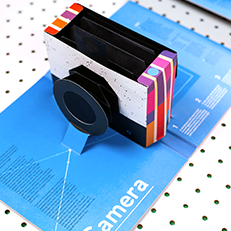
Kelli Anderson is an artist/designer and tinkerer who draws, photographs, cuts, prints, codes, and creates a variety of designed things for herself and others. From interactive paper to layered, experimental websites, everything begins and ends in her studio which houses a 1919 letterpress and an assortment of other benevolent contraptions. This Fall, she will publish a book, entitled This Book is a Planetarium, about how humble materials can perform extraordinary feats—and featuring a tiny, pop-up planetarium and other functional contraptions.
On Lo-fi Magic
The stuff of everyday life that we see day-in/day-out is what inevitably fades into the background—as to become invisible. In this way, superficial familiarity blocks us from asking deeper structural questions of materials that we take for granted—like paper.
This state of complacency actually presents an opportunity wide open: we can "hack" these worn-out experiences and figure out what surreal/awesome things they can do.
In my work as a designer, I try to better understand how things work so that I might demonstrate their surprising capabilities hidden in plain sight. However, lo-fi research methods are also being used in [what would traditionally be considered] high-tech fields. Using strategies like origami, engineering labs are also seeking ways to make complex problems tangible—to open then up to physical intuition.
By engaging abstractions tangibly, we often find surprising possibilities hidden in plain view.
This state of complacency actually presents an opportunity wide open: we can "hack" these worn-out experiences and figure out what surreal/awesome things they can do.
In my work as a designer, I try to better understand how things work so that I might demonstrate their surprising capabilities hidden in plain sight. However, lo-fi research methods are also being used in [what would traditionally be considered] high-tech fields. Using strategies like origami, engineering labs are also seeking ways to make complex problems tangible—to open then up to physical intuition.
By engaging abstractions tangibly, we often find surprising possibilities hidden in plain view.






